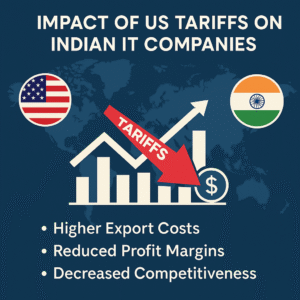Impact of US Tariffs on Indian IT Companies

The Indian IT sector, a cornerstone of the nation’s economy and a significant contributor to its exports, has long enjoyed a robust relationship with the United States, its largest market. However, recent trade policy shifts in the US, particularly the imposition of new tariffs on various goods, cast a shadow of uncertainty over the future of this crucial partnership. While these tariffs may not directly target IT services, their indirect consequences could significantly impact Indian IT companies.
The United States accounts for a substantial portion of the revenue for Indian IT giants like TCS, Infosys, HCL Technologies, and Tech Mahindra. Any economic headwinds in the US, triggered by tariffs or otherwise, are bound to have a ripple effect on the Indian IT industry.
Indirect Economic Impact
The primary concern revolves around the potential for a US economic slowdown induced by the tariffs. As the cost of imported goods rises due to tariffs, inflationary pressures may build, leading to tighter budgets for American businesses. This belt-tightening could translate into reduced discretionary spending, directly impacting IT outsourcing budgets. Sectors heavily reliant on the US market, such as manufacturing, retail, and logistics, might face financial strain, leading to contract renegotiations, pricing pressure, and project postponements for Indian IT service providers.
Analysts predict that this could result in a slowdown in deal cycles and a delay in existing projects, ultimately hurting the revenue growth of Indian IT companies. Furthermore, with rising fears of a US recession, investments in next-generation technologies might also see a slowdown as clients become more cautious with their spending.
Impact on IT Stocks and Investor Sentiment
The announcement of US tariffs has already triggered a negative sentiment among investors. The Nifty IT index experienced a significant dip, reflecting concerns about the sector’s future prospects. Companies with a higher revenue dependency on the US market have seen a more pronounced impact on their stock prices. This sell-off indicates a growing apprehension about the potential hit to the earnings and growth outlook of Indian IT firms.
Potential Long-Term Adjustments
Faced with these challenges, Indian IT companies may need to strategize and adapt. Some potential long-term adjustments could include:
- Cost Optimization: Firms might focus on optimizing their operational costs to maintain profitability in the face of pricing pressures.
- Market Diversification: Exploring and expanding into new markets beyond the US could reduce over-reliance on a single region.
- Service Diversification: Diversifying service offerings to cater to evolving client needs, including a greater focus on AI and automation, could create new revenue streams.
- Increased Local Hiring in the US: To mitigate potential restrictions on work visas and to better align with the US market’s demands, a greater emphasis on local hiring within the US might be observed.
Silver Linings?
While the overall outlook appears challenging, some analysts suggest that certain segments within the Indian export basket might find a relative advantage due to the US tariffs on other countries. For instance, the textile industry might see a boost as US buyers potentially shift sourcing from countries facing higher tariffs. Similarly, the pharmaceutical sector is currently exempt from these tariffs and could see growth. However, the IT services sector, with its significant reliance on the US, remains vulnerable to the indirect economic consequences.
Final Thoughts
The imposition of US tariffs, while not directly targeting the Indian IT sector, poses a significant indirect threat. The potential for a US economic slowdown and the subsequent tightening of client budgets could lead to reduced spending on IT services, impacting the revenue and growth of Indian IT companies. While the sector has shown resilience in the past, navigating this new trade landscape will require strategic adjustments, including cost optimization, market diversification, and service innovation, to mitigate the looming shadow of US tariffs. The coming fiscal year will be crucial in determining the true extent of this impact and the effectiveness of the Indian IT sector’s response.


